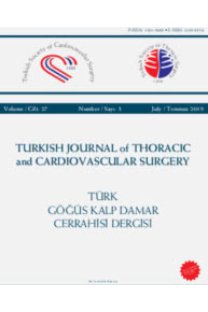Koroner arter baypas greftleme cerrahisi uygulanan kronik obstrüktif akciğer hastalığı tanılı hastalarda respiratuvar kas gücünün araştırılması
Investigation of respiratory muscle strength in patients with chronic obstructive pulmonary disease undergoing coronary artery bypass grafting surgery
___
- 1.Weiner P, Zeidan F, Zamir D, Pelled B, Waizman J, Beckerman M, et al. Prophylactic inspiratory muscle training in patients undergoing coronary artery bypass graft. World J Surg 1998;22:427-31.
- 2.Shapiro BA, Lichtenthal PR. Postoperative respiratory management. In: Kaplan JA, editor. Cardiac anesthesia. Philadelphia: W. B Saunders Company; 1999. p. 1215-32.
- 3.Chetta A, Bobbio A, Aiello M, Del Donno M, Castagnaro A, Comel A, et al. Changes in lung function and respiratory muscle strength after sternotomy vs. laparotomy in patients without ventilatory limitation. Eur Surg Res 2006;38:489-93.
- 4.Türkay C, Akbulut E, Özbudak Ö, Gölbaşı İ, Şahin N, Mete A ve ark. Koroner bypass cerrahisi uygulanan hastalarda kronik obstrüktif akciğer hastalığının mortalite ve morbiditeye etkisi. Turk Gogus Kalp Dama 2000;8:678-81.
- 5.Kabitz HJ, Walterspacher S, Walker D, Windisch W. Inspiratory muscle strength in chronic obstructive pulmonary disease depending on disease severity. Clin Sci (Lond) 2007;113:243-9.
- 6.Steier J, Kaul S, Seymour J, Jolley C, Rafferty G, Man W, et al. The value of multiple tests of respiratory muscle strength. Thorax 2007;62:975-80.
- 7.American Thoracic Society/European Respiratory Society. ATS/ERS Statement on respiratory muscle testing. Am J Respir Crit Care Med 2002;166:518-624.
- 8.Gray-Donald K, Gibbons L, Shapiro SH, Macklem PT, Martin JG. Nutritional status and mortality in chronic obstructive pulmonary disease. Am J Respir Crit Care Med 1996;153:961-6.
- 9.Bégin P, Grassino A. Inspiratory muscle dysfunction and chronic hypercapnia in chronic obstructive pulmonary disease. Am Rev Respir Dis 1991;143:905-12.
- 10.Zielinski J, MacNee W, Wedzicha J, Ambrosino N, Braghiroli A, Dolensky J, et al. Causes of death in patients with COPD and chronic respiratory failure. Monaldi Arch Chest Dis 1997;52:43 -7.
- 11.Global initiative for chronic obstructive lung disease. Pocket Guide to COPD Diagnosis, Management, and Prevention. A Guide for physicians and nurses. based on NHLBl/WHO Workshop Report Global Strategy for the diagnosis, management, and prevention of COPD. National Institutes of Health. National Heart, Lung, and Blood Institute. Updated 2003.
- 12.Morsch KT, Leguisamo CP, Camargo MD, Coronel CC, Mattos W, Ortiz LD, et al. Ventilatory profile of patients undergoing CABG surgery. Rev Bras Cir Cardiovasc 2009;24:180-7.
- 13.Vargas FS, Cukier A, Terra-Filho M, Hueb W, Teixeira LR, Light RW. Relationship between pleural changes after myocardial revascularization and pulmonary mechanics. Chest 1992;102:1333-6.
- 14.Worth H, Grundmann C, Goeckenjan G, Smidt U, Irlich G, Loogen F. Electromyographic determination of the fatigability of respiratory and leg muscles before and after aortocoronary bypass operation. Respiration 1984;46:33-44. [Abstract]
- 15. Coronel CC, Bordignon S, Bueno AD, Lima LL, Nesralla I. Perioperative variables of ventilatory function and physical capacity in heart transplant patients. Rev Bras Cir Cardiovasc 2010;25:190-6
- ISSN: 1301-5680
- Yayın Aralığı: 4
- Başlangıç: 1991
- Yayıncı: Bayçınar Tıbbi Yayıncılık
Heparine bağlı trombositopeni öyküsü olan bir hastada tekrar ameliyat
Ozan KARAKİŞİ, Erol ŞENER, Levent ÇETİN, Ayşegül KUNT, Mete HIDIROĞLU, Aslıhan KÜÇÜKER
De novo right atrial myxoma detected nine months after atrial septal defect closure
Hüseyin Ali TÜNEL, Öner GÜLCAN, Murat GÜVENER, Orhan Saim DEMİRTÜRK
Trakeal mukoepidermoid karsinom: Nadir bir olgunun sunumu
Oktay BAŞOK, Sülün ERMETE, Kenan Can CEYLAN, Ozan USLUE, Deniz AKPINAR, Ayşe ÖZSÖZ
Travmatik aortik rüptür ve cerrahi onarım
Mehmet ÖZKÖKELİ, Hasan SUNAR, Rahmi ZEYBEK, Altuğ TUNCER, Ahmet ŞAŞMAZEL, Saleh ALSALEHI
Pektus karinatum ve iki taraflı servikal kosta anomalisi: Olgu sunumu
Aortic occlusion: Five case reports
Nazif ERKAN, Gökhan ELÇİN, Serhat AKAY
Giant liposarcoma in hemithorax
Mertol GÖKÇE, Özkan SAYDAM, Remzi ALTIN, Gamze YURDAKAN
Vein of Galen aneurysm in a newborn baby
Nilgün KÜLTÜRSAY, Füsun ATLIHAN, Mustafa PARILDAR, Şebnem ÇALKAVUR, Vedide TAVLI, Özgür OLUKMAN, Nuh YILMAZ
Mediastinit tedavisinde enfekte sternotomi yaralarına yaklaşım
Mustafa DURGUN, Emre İNÖZÜ, Ali Teoman TELLİOĞLU, Suna DURGUN ÖGÜCÜ, Hülda ÖZAKPINAR RIFAT, Avni Tolga ERYILMAZ, Hüseyin Fatih ÖKTEM
